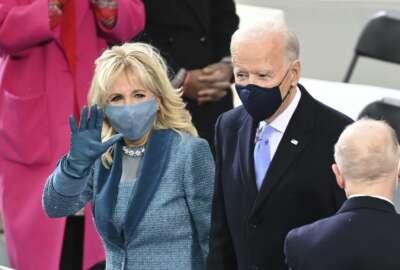Biden creates sweeping diversity and inclusion initiative through new executive order
The executive order, which President Joe Biden signed Friday, addresses everything from unpaid federal internships and pay equity for members of underserved...
Agencies have new marching orders to promote and improve diversity, equity, inclusion and accessibility within the federal workforce, thanks to a sweeping new executive order from the Biden administration.
The executive order, which President Joe Biden signed Friday evening, details the administration’s vision for a federal workforce “that looks like America.” It touches on nearly every aspect of federal employment, from recruitment and hiring to training, leadership development, and employee pay and benefits.
In a fact sheet describing the EO, the Biden administration said members of underserved communities are still underrepresented inside the federal workforce, particularly among senior leaders. “Enduring legacies of employment discrimination, systemic racism and gender inequality are still felt today,” the White House said.
“The federal government is at its best when drawing upon all parts of society, our greatest accomplishments are achieved when diverse perspectives are brought to bear to overcome our greatest challenges and all persons should receive equal treatment under the law,” the order reads. “This order establishes that diversity, equity, inclusion and accessibility are priorities for my administration and benefit the entire federal government and the nation, and establishes additional procedures to advance these priorities across the federal workforce.”
Under the new order, the Office of Personnel Management and Office of Management and Budget will reestablish a governmentwide diversity, equity, inclusion and accessibility (DEIA) initiative and will develop a new four-year strategic plan.
Individual agencies must make diversity, equity, inclusion and accessibility a priority within their management agendas, and they have 100 days to assess the state of DEIA within their own workforces and human capital practices.
Biden’s new diversity and inclusion order is, by all accounts, detailed and comprehensive, but it’s not without precedent. Former President Barack Obama called for a similar governmentwide diversity and inclusion strategic plan through a 2011 executive order.
The Biden administration said it took inspiration from Obama’s efforts. But unlike previous initiatives, this new order has a vastly broader scope.
The Biden EO instructs agencies to focus on advancing both diversity and inclusion, as well as equity and accessibility. OPM and OMB have significant leadership roles in implementing the order, but so do several other agencies.
“The initiative will advance opportunity for communities that have historically faced employment discrimination and professional barriers, including: people of color; women; first-generation professionals and immigrants; individuals with disabilities; LGBTQ+ individuals; Americans who live in rural areas; older Americans who face age discrimination when seeking employment; parents and caregivers who face employment barriers; people of faith who require religious accommodations at work; individuals who were formerly incarcerated; and veterans and military spouses,” the White House fact sheet reads.
Specifically, the new EO requires agencies to identify barriers to recruiting, hiring, retaining and promoting individuals from underserved populations, as well as any obstacles they might face with professional development, pay and compensation, or training and reasonable accommodations.
The order asks agencies to examine their own practices and determine the extent to which those policies promote potentially inequitable outcomes, and, using evidence, assess any ongoing diversity and inclusion initiatives.
Agencies must report annually on their progress toward meeting both the governmentwide strategic DEIA plan and their own individual plans — and set quarterly goals that measure their success in advancing diversity, equity, inclusion and accessibility within their own workforce and workplace culture.
The order also encourages agencies to establish or elevate chief diversity officers at the senior levels of their organizations. Several agencies, including the State and Agriculture departments, have already done so within the first six months of the Biden administration.
OPM to lead pay equity review, expansion of D&I training
Notably, the new EO orders agencies to expand diversity, equity, inclusion and accessibility training for federal employees, managers and leaders.
“Such training programs should enable federal employees, managers, and leaders to have knowledge of systemic and institutional racism and bias against underserved communities, be supported in building skillsets to promote respectful and inclusive workplaces and eliminate workplace harassment, have knowledge of agency accessibility practices, and have increased understanding of implicit and unconscious bias,” the order reads.
This new directive comes after Biden rescinded the previous administration’s ban on certain kinds of diversity and inclusion training. The Trump administration’s ban effectively paused most types of diversity and inclusion training within agencies — and sparked a debate inside government about the content and messages of those programs.
In addition, the new diversity and inclusion order instructs OPM to review governmentwide pay and compensation policies — and identify any inequities.
“Many workers continue to face racial and gender pay gaps, and pay inequity disproportionately affects women of color,” the Biden administration said.
OPM will work with other agencies on potential job classification and compensation policy changes, and it’ll prohibit them from asking or using an applicant’s salary history to set employee wages. A coalition of employee affinity groups at the Justice Department has previously raised concerns about such practices.
Also unlike previous governmentwide diversity and inclusion initiatives, Biden’s EO emphasizes data and evidence in promoting DEIA initiatives inside federal agencies.
The order, for example, calls on agencies to measure demographic representation inside their organizations and track trends on employment applications, hiring decisions, attrition, professional development and composition of the senior leader workforces.
OPM, OMB and the Equal Employment Opportunity Commission will review whether regulatory changes are necessary to collect more demographic data about the federal workforce, the EO said.
In addition, OPM and OMB will find ways to collect more demographic data about participation in professional and leadership development programs — and the rate of placing those participants into senior leader positions. Agencies will use that data to ensure they’re reaching diverse candidates, according to the EO.
As Federal News Network reported last week, the federal government’s signature leadership development program is failing to attract and select candidates from diverse backgrounds, and the Senior Executive Service has traditionally struggled to recruit minorities and women.
Fewer unpaid internships, more hiring partnerships
Notably, Biden’s new executive order directs agencies to reduce their reliance on unpaid internships and increase the number of paid opportunities.
Agencies should use paid internships as a supplement to the competitive hiring process, not a replacement, the EO said.
The order also establishes a new “Partnerships Initiative,” which is designed to help agencies recruit more individuals from underserved communities into federal service. The Office of Science and Technology Policy, as well as OPM and OMB, will lead the initiative and will strengthen partnerships with historically Black colleges, minority serving institutions and others.
Agencies will work with OSTP, OPM and OMB to make internships, apprenticeships, fellowships and other opportunities available through this new Partnerships Initiative.
“This executive order will help in our efforts to recruit, retain, and honor the most effective workforce, one in which federal employees from all backgrounds and walks of life feel included and valued,” OPM Director Kiran Ahuja, who was sworn in last week, said in a statement. “These types of efforts are best practices for major employers across sectors seeking to stay competitive in the marketplace, and OPM is looking forward to working with all of our federal partners as we better position our workforce for the future.”
A ‘model employer’ for LGBTQ+ employees
Biden’s new order goes on to detail the steps the administration will take to make the federal workforce more accessible for specific underserved populations.
OPM, for example, will assess how agencies are using the Schedule A hiring authority to bring on people with disabilities. The General Services Administration will lead an initiative to ensure federal buildings comply with physical accessibility standards.
Agencies will ensure their employee support services accommodate LGBTQ+ employees, including “transgender and gender non-conforming and non-binary employees who wish to legally, medically or socially transition,” the order said.
OPM and the Pentagon will assess whether LGBTQ+ employees have equitable healthcare coverage through the Federal Employees Health Benefits Plan and Military Health System.
All agencies will update hiring and benefits enrollments forms to include non-binary gender marker and pronoun options, while the National Institute of Standards and Technology will update employee identification and credential standards to reflect the needs of transgender and non-binary workers.
The Office of the Director of National Intelligence will review potential barriers within the security clearance process for LGBTQ+ employees, the order said.
Finally, the EO gives OPM new authorities to evaluate and expand federal hiring opportunities for formerly incarcerated people.
“As the nation’s largest employer, the federal government must be a model for diversity, equity, inclusion and accessibility, where all employees are treated with dignity and respect,” the order reads. “A growing body of evidence demonstrates that diverse, equitable, inclusive and accessible workplaces yield higher-performing organizations.”
Copyright © 2025 Federal News Network. All rights reserved. This website is not intended for users located within the European Economic Area.
Nicole Ogrysko is a reporter for Federal News Network focusing on the federal workforce and federal pay and benefits.
Follow @nogryskoWFED






